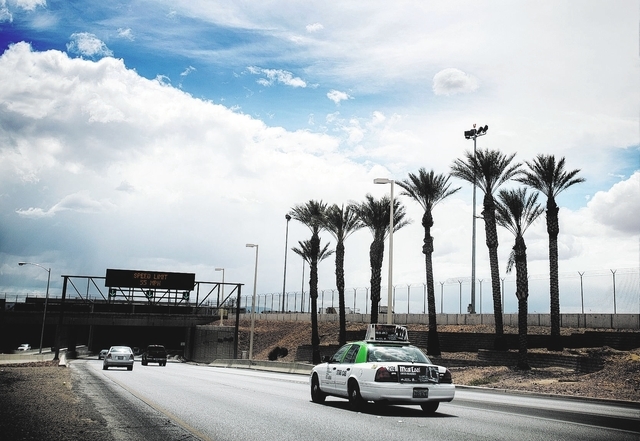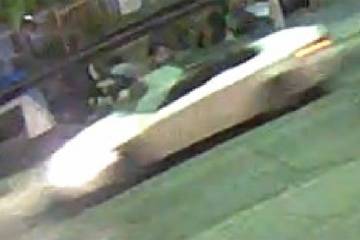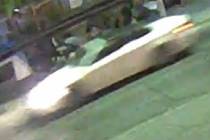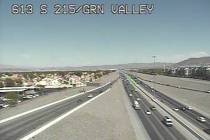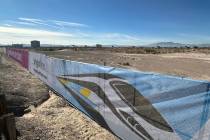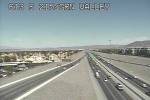Long-hauling problem: Insight from two Las Vegas cabdrivers
They’re reviled by honest cabdrivers, threatened by their cab company bosses and criticized by the rest of the tourism industry and the media.
They’re long-haulers.
They will deliberately take their cab customers from one point to another by a longer route than necessary because they can collect more fare money at the end of the ride.
They know what they’re doing is illegal, but they do it anyway for a variety of reasons.
If they get caught, it might be one strike against them if their company has a three-strikes-and-you’re-out policy. Or, maybe their bosses will simply fire them on the spot.
They live within the gray areas of the law in an environment that only wants to see black and white.
The Nevada Taxicab Authority has spent years using various tactics to catch them and drum them out of the industry. Cab company owners say they’re doing what they can to rid their work forces of them. But long-hauling is still a common occurrence.
MEET JACK AND JOE
The Review-Journal made contact with two admitted taxi long-haulers who only agreed to talk about why they do it if their identities are not revealed.
The two drivers — we’ll call them Jack and Joe — have worked for their companies for years.
They say the main reason they cheat is because they are under daily pressure to generate fares within a certain percentage of the average revenue brought in by the rest of the drivers of that shift.
Joe says his daily take must be within 15 percent of the average, a constantly changing number. There have been days when Jack and Joe believed they had a pretty good day only to find that they fell below the average.
“With these companies, it’s all about the average,” Joe said. “It’s not written down anywhere, but if you don’t meet the average, you will not drive. Or you’ll be (assigned to) a radio cab, or you’ll be (in) a restricted cab. So there’s a lot of pressure to keep up with the average.”
Radio cabs are those dedicated to local calls where a driver will receive an assignment from a radio dispatcher.
A geographically restricted cab is designated to a specific area. Drivers can take passengers to a restricted area, but can’t pick up passengers there.
DISCIPLINING DRIVERS
When drivers fail to make the percentage of the book average, they face a disciplinary action — a trip to a driving counselor or a one-day suspension. If they fall short of the average regularly, they’ll lose their jobs.
That motivates them to do what’s necessary to hit the revenue target, and sometimes that means riding on the edge of the long-hauling regulations.
“It’s one little incident and you’re gone,” Joe said. “If you don’t bring in the money that they want, you’re gone.”
Both Jack and Joe say they don’t long-haul as much now as they have in the past. But sometimes they bend the rules just a little.
“There are long-haulers and there are people who kidnap people,” Jack said. “I don’t consider what I do long-hauling.”
Under the taxi regulations, if drivers intend to take a route longer than the most direct one, they must first get permission from the customer.
Long-hauling occurs most often from McCarran International Airport to a Strip resort. Instead of driving north on Swenson Street and using surface streets, they will take the tunnel near McCarran to the 215 Beltway, heading north on Interstate 15 to the exit closest to the resort.
That usually adds an extra $8 to $10 to a fare.
Do that enough times and a driver can pocket an extra $50 to $100 a shift.
GRAY AREAS
But here’s where it becomes a gray area. Not every ride through the tunnel is a long-haul, which is why the Taxicab Authority won’t ticket the drivers of every cab using the tunnel.
Former Clark County Aviation Department Director Randall Walker frequently said the airport tunnel was built to alleviate traffic jams on Paradise Road and Swenson at Tropicana Avenue by offering an alternative route to and from the airport.
If a lot of traffic is on the streets — during morning or evening rush hours, when a convention is letting out or when there’s a big event at the Thomas &Mack Center — the ride can be more expensive on surface streets.
That’s because taxi meters charge by distance and time when the vehicle is stopped or bogged down in traffic.
HOW METERS WORK
The meters charge $2.60 a mile — it’s broken down as 20 cents per every one-thirteenth of a mile — and $30 an hour for “wait time.” The way that breaks out is that the meter adds 20 cents every 24 seconds the cab is stationary or traveling under 12 mph.
When a vehicle sits through multiple traffic signal cycles, the total can add up quickly.
When there’s traffic, a driver can ask permission to drive a longer route to avoid it. If the customer agrees, the driver is in compliance.
Sometimes, a customer will ask the driver to “take me there as quickly as you can,” an open invitation to drive the longer route.
Other times, drivers will ask customers for directions seconds before they have to commit between taking the tunnel or taking surface streets.
“I could literally get people from the airport to the Palazzo in six minutes,” Jack said. “But when it’s busy, sometimes you’re waiting at a traffic light for six minutes. Every ride, I ask if they prefer to go the streets or the highway.”
Even though a tunnel trip isn’t necessarily a long-haul, Jack and Joe cited instances in which Taxicab Authority enforcement officers wrote a driver a ticket for long-hauling despite getting permission to go the longer route.
Jack was one of those drivers.
“The first thing he (the enforcement officer) said to my customers was, ‘He’s lying to you and he’s robbing from you.’ Those were the first words out of his mouth,” he said.
WRITING CITATIONS
The Taxicab Authority has had an uneven record for issuing long-hauling citations. At times, they will write them in bunches, interviewing drivers and their passengers at hotel cab stands before writing a ticket or conducting undercover stings.
At other times, few citations are written.
Taxicab Authority Administrator Charles Harvey said in a recent interview that the drop-off in citations issued in the last three months of 2013 appeared to be an orchestrated effort to make him and the agency look bad. Harvey said he is working with his staff to root out those who believe he’s unqualified to run the agency because he doesn’t have a law enforcement background.
While the Taxicab Authority has been hot and cold in its long-hauling enforcement, Joe thinks the cab companies could do a lot more to end the practice.
TALKING A GOOD GAME
“They talk a pretty good game publicly, but with the drivers, they don’t come straight out and say it, but they also don’t do a thing to stop it,” Joe said. “If somebody comes in with a trip sheet that says airport-to-Monte Carlo, $45, a red flag should fly. It’s only a $16 fare. But they do nothing except say, ‘Give me your money.’ ”
He said penalizing the companies wouldn’t do much good because “to a company that nets $100 million, a $200 fine won’t mean anything.”
Cab company owners dispute the claim.
In a recent editorial board meeting with the Review-Journal, leaders of Yellow Checker Star, the Bell Transportation group companies and Frias Transportation Management recalled instances in which they fired drivers immediately when they learned of a blatant long-hauling incident.
Drivers cited for long-hauling are placed by driver number on a new long-hauling database posted by the Taxicab Authority.
“When one of my drivers is fired, the first thing I do is make sure I get that guy on the long-hauling database,” said Brent Bell, who heads Bell Transportation. “And, when I’m hiring someone, I make sure he’s not on the list for something that happened at another company.”
Drivers have their own suspicions about which companies are lax about how they view long-hauling.
“It’s pretty obvious,” Joe said. “Just look at how much some of the small companies bring in.”
REVENUE PER SHIFT
The Taxicab Authority publishes monthly ridership statistics. One of the measures is revenue per shift. Two of the city’s smallest companies — Desert Cab and Nellis Cab — consistently collect the most revenue per shift.
In March, for example, the industry average was $308.99. In that month, Desert reported $386.54 and Nellis had $370.64. The largest companies were right about at the average.
“It’s not because they’re such great workers,” Jack said. “Nellis and Desert are the highest bookers because they’re long-hauling the most.”
But Nellis and Desert also have among the highest number of trips per shift, on average about two more than the industry average. George Balaban, who owns Desert Cab, said his drivers are directed to move quickly to a taxi stand close to where they dropped off their last customer rather than make repeated runs to the airport. He also encourages his drivers to mix in radio calls to local residents, rides that often have higher fares than the quick turns on the Strip.
Joe also said drivers are compelled to long-haul because there are more and more cabs placed on the streets and that cuts into each driver’s income. He said the companies are always seeking more cabs when there are big events in town.
Although the Taxicab Authority makes its decisions on special allocations based on serving the riding public, the companies enjoy the benefit because they will collect more fare revenue as well as the advertising revenue that goes along with signage on vehicles and messaging inside the cars. Drivers don’t get a cut of any advertising revenue.
“The more cabs they have out there, the more advertising revenue they can generate,” Joe said.
UPSELLING
Another gray area in the generation of taxi revenue is in the practice of upselling. In an interview with the Review-Journal, Balaban said his company trains its drivers to provide added service to their customers by telling them of some of the things the city has to offer.
Balaban said his drivers will ask customers if they want their pictures taken at the “Welcome to Fabulous Las Vegas” sign or if they want to stop at a liquor store so they don’t have to pay steep prices for beverages in the hotel room.
He views it as good salesmanship, just as a waiter who tries to persuade diners to buy an appetizer; some drivers see it as diversion, another taxi industry no-no.
A diversion occurs when a driver takes customers to places they don’t ask to go.
It most commonly occurs on rides to nightclubs that pay kickbacks to cabdrivers for delivering customers.
“They’re providing a customer with options,” said Jonathan Schwartz, a director for Yellow Checker Star. “It’s not a diversion. The customer always directs the taxi driver.”
How widespread is long-hauling? When you ask cabdrivers, they say it happens all the time. Ask the owners and they’ll say it’s rare.
“It’s a big problem, but a small amount of drivers are turning it into the media frenzy that it has become,” Schwartz said.
Schwartz said his company gets “very few” complaints in the approximately 600,000 rides they give each month.
Bell said his company receives from 10 to 12 complaints a month for an average 350,000 rides.
John Hickman, chief operating officer of Frias, said he gets 10 to 15 complaints a month on an estimated 750,000 rides.
At those companies, drivers are required to compensate their customers when a long-hauling complaint is made. Bell and Schwartz said drivers are directed to buy a money order for the total of the fare to be mailed to the complaining customer.
FLAT RATES AND ZONES
Is there any surefire way to stop long-hauling? While the Taxicab Authority is looking at the possibility of having GPS-based technology installed that would track cabs in real time and can be programmed to detect unusual trips that appear to be long-hauls, the drivers say there is a much simpler solution: flat-rate pricing.
Flat rates are used in many cities around the country; in many of them, they are used only on common trips, like from an airport to a convention center.
Chicago, Miami and Dallas are among the cities that have meters for many trips, but flat-rate zones from an airport.
Jack and Joe think that would work well in Las Vegas, because drivers could then take whatever route would be best to get in line for the next fare.
Some local transportation officials have looked at that and envision one rate for the airport to a resort south of Tropicana Avenue, another rate for a resort south of Flamingo Road, another for a location south of Spring Mountain Road and others south of Sahara Avenue and into downtown.
IT WON’T WORK
But cab companies say it won’t work. In fact, they say similar flat-rate systems set up in Cleveland and Washington, D.C., were abandoned because of the problems they created.
“Flat rates don’t work because in most cities where they’re implemented, they’ll either overcharge the customer or undercharge,” Schwartz said. “Both are unacceptable. The fairest way to assess a charge in the taxi industry is with a meter, measuring distance and time.”
Schwartz said zoned flat rates in Washington were eliminated “because it was a bigger fraud problem.” He said drivers would drive through a farther zone to get to a closer zone and charge the rate of the farther zone.
In Cleveland, he said, drivers quit picking up passengers at the airport because they wouldn’t make as much money from the flat rates from the airport than they would on metered rides.
PREVENT BEING A VICTIM
Is there anything customers can do to prevent being long-hauled?
The Taxicab Authority asks customers who have been long-hauled to give a statement to authority officers to help in the prosecution of a driver. Sometimes that’s hard to get, because an officer will contact them in mid-ride or at the conclusion of the ride, and all the customers want to do at that point is get to their hotel rooms.
Jack’s tip is for customers not to let on that they are tourists or, at least, give the impression that they know their way around.
“You really have to be careful what you say when you’re a tourist,” Jack said. “Some drivers will ask, ‘Is this your first time here,’ and if they say, ‘Yes,’ done, it’s all over. They want to go to The Mirage so they go out the tunnel, out to the 215, down to Decatur, take a right on Decatur to Spring Mountain and then down to The Mirage. I know guys who do that every day. But even I couldn’t do that.”
Jack said he doesn’t feel like he is doing anything wrong because he asks his customers first.
“But I really do feel bad for some of these people because it’s a robbery.”
Contact Richard N. Velotta at rvelotta@reviewjournal.com or 702-477-3893. Find him on Twitter: @RickVelotta.




